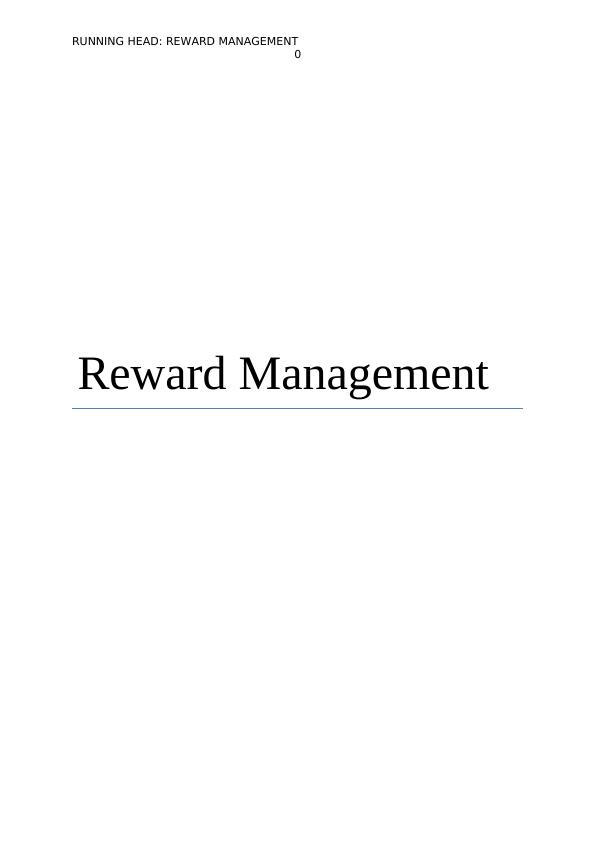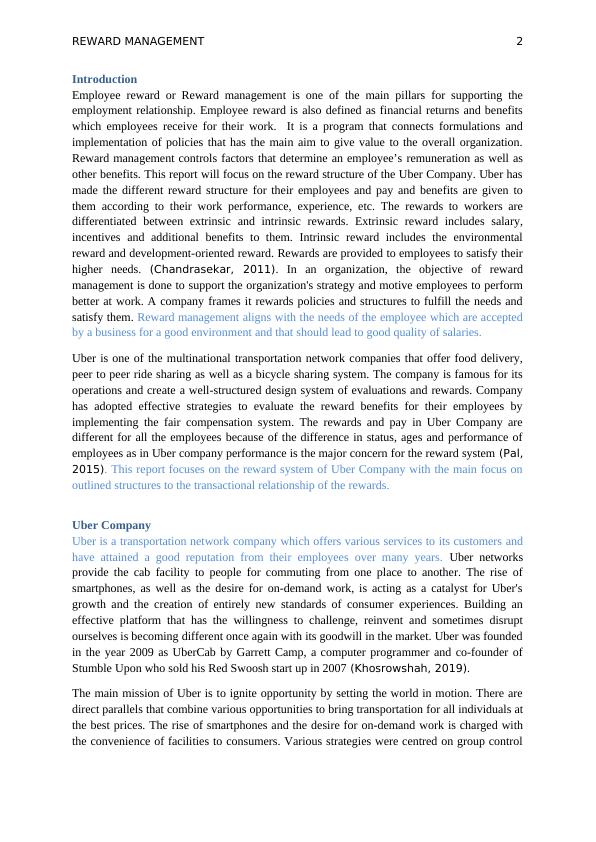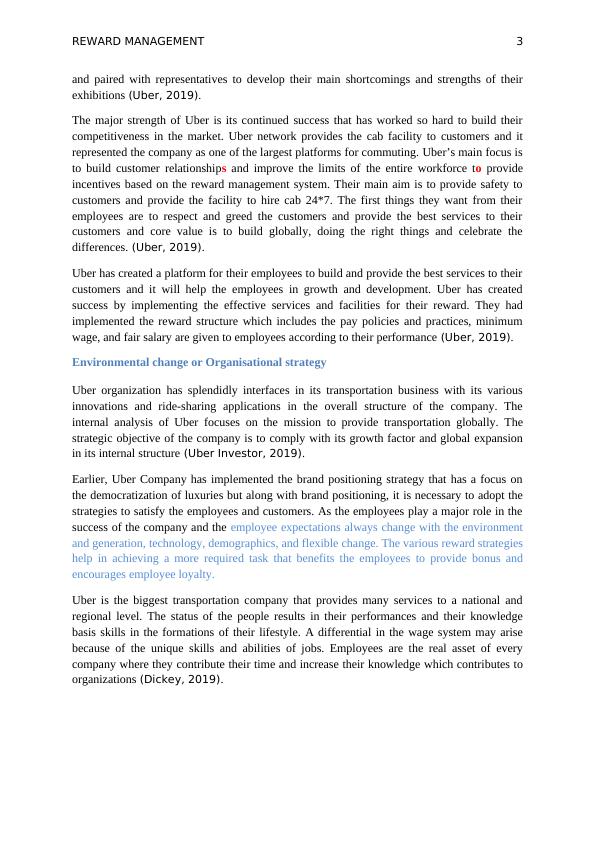Reward Management in Uber Company
Added on 2022-11-19
12 Pages4477 Words496 Views
RUNNING HEAD: REWARD MANAGEMENT
0
Reward Management
0
Reward Management

REWARD MANAGEMENT 1
Table of Contents
Introduction............................................................................................................... 1
Uber Company........................................................................................................... 2
Environmental change or Organisational strategy.............................................................3
Area of Employment and Differences in Pay...................................................................3
Pay differences between Uber Employees.......................................................................4
Fixed Price Incentive Awards...................................................................................... 4
Conceptual Apparatus.................................................................................................. 5
Organization Target Fixed Price Incentives........................................................................6
Differences in Pay Between Employees.........................................................................6
Reward System in International Context............................................................................7
Issues in Reward Management........................................................................................ 7
Conclusions............................................................................................................... 8
Bibliography.............................................................................................................. 9
Table of Contents
Introduction............................................................................................................... 1
Uber Company........................................................................................................... 2
Environmental change or Organisational strategy.............................................................3
Area of Employment and Differences in Pay...................................................................3
Pay differences between Uber Employees.......................................................................4
Fixed Price Incentive Awards...................................................................................... 4
Conceptual Apparatus.................................................................................................. 5
Organization Target Fixed Price Incentives........................................................................6
Differences in Pay Between Employees.........................................................................6
Reward System in International Context............................................................................7
Issues in Reward Management........................................................................................ 7
Conclusions............................................................................................................... 8
Bibliography.............................................................................................................. 9

REWARD MANAGEMENT 2
Introduction
Employee reward or Reward management is one of the main pillars for supporting the
employment relationship. Employee reward is also defined as financial returns and benefits
which employees receive for their work. It is a program that connects formulations and
implementation of policies that has the main aim to give value to the overall organization.
Reward management controls factors that determine an employee’s remuneration as well as
other benefits. This report will focus on the reward structure of the Uber Company. Uber has
made the different reward structure for their employees and pay and benefits are given to
them according to their work performance, experience, etc. The rewards to workers are
differentiated between extrinsic and intrinsic rewards. Extrinsic reward includes salary,
incentives and additional benefits to them. Intrinsic reward includes the environmental
reward and development-oriented reward. Rewards are provided to employees to satisfy their
higher needs. (Chandrasekar, 2011). In an organization, the objective of reward
management is done to support the organization's strategy and motive employees to perform
better at work. A company frames it rewards policies and structures to fulfill the needs and
satisfy them. Reward management aligns with the needs of the employee which are accepted
by a business for a good environment and that should lead to good quality of salaries.
Uber is one of the multinational transportation network companies that offer food delivery,
peer to peer ride sharing as well as a bicycle sharing system. The company is famous for its
operations and create a well-structured design system of evaluations and rewards. Company
has adopted effective strategies to evaluate the reward benefits for their employees by
implementing the fair compensation system. The rewards and pay in Uber Company are
different for all the employees because of the difference in status, ages and performance of
employees as in Uber company performance is the major concern for the reward system (Pal,
2015). This report focuses on the reward system of Uber Company with the main focus on
outlined structures to the transactional relationship of the rewards.
Uber Company
Uber is a transportation network company which offers various services to its customers and
have attained a good reputation from their employees over many years. Uber networks
provide the cab facility to people for commuting from one place to another. The rise of
smartphones, as well as the desire for on-demand work, is acting as a catalyst for Uber's
growth and the creation of entirely new standards of consumer experiences. Building an
effective platform that has the willingness to challenge, reinvent and sometimes disrupt
ourselves is becoming different once again with its goodwill in the market. Uber was founded
in the year 2009 as UberCab by Garrett Camp, a computer programmer and co-founder of
Stumble Upon who sold his Red Swoosh start up in 2007 (Khosrowshah, 2019).
The main mission of Uber is to ignite opportunity by setting the world in motion. There are
direct parallels that combine various opportunities to bring transportation for all individuals at
the best prices. The rise of smartphones and the desire for on-demand work is charged with
the convenience of facilities to consumers. Various strategies were centred on group control
Introduction
Employee reward or Reward management is one of the main pillars for supporting the
employment relationship. Employee reward is also defined as financial returns and benefits
which employees receive for their work. It is a program that connects formulations and
implementation of policies that has the main aim to give value to the overall organization.
Reward management controls factors that determine an employee’s remuneration as well as
other benefits. This report will focus on the reward structure of the Uber Company. Uber has
made the different reward structure for their employees and pay and benefits are given to
them according to their work performance, experience, etc. The rewards to workers are
differentiated between extrinsic and intrinsic rewards. Extrinsic reward includes salary,
incentives and additional benefits to them. Intrinsic reward includes the environmental
reward and development-oriented reward. Rewards are provided to employees to satisfy their
higher needs. (Chandrasekar, 2011). In an organization, the objective of reward
management is done to support the organization's strategy and motive employees to perform
better at work. A company frames it rewards policies and structures to fulfill the needs and
satisfy them. Reward management aligns with the needs of the employee which are accepted
by a business for a good environment and that should lead to good quality of salaries.
Uber is one of the multinational transportation network companies that offer food delivery,
peer to peer ride sharing as well as a bicycle sharing system. The company is famous for its
operations and create a well-structured design system of evaluations and rewards. Company
has adopted effective strategies to evaluate the reward benefits for their employees by
implementing the fair compensation system. The rewards and pay in Uber Company are
different for all the employees because of the difference in status, ages and performance of
employees as in Uber company performance is the major concern for the reward system (Pal,
2015). This report focuses on the reward system of Uber Company with the main focus on
outlined structures to the transactional relationship of the rewards.
Uber Company
Uber is a transportation network company which offers various services to its customers and
have attained a good reputation from their employees over many years. Uber networks
provide the cab facility to people for commuting from one place to another. The rise of
smartphones, as well as the desire for on-demand work, is acting as a catalyst for Uber's
growth and the creation of entirely new standards of consumer experiences. Building an
effective platform that has the willingness to challenge, reinvent and sometimes disrupt
ourselves is becoming different once again with its goodwill in the market. Uber was founded
in the year 2009 as UberCab by Garrett Camp, a computer programmer and co-founder of
Stumble Upon who sold his Red Swoosh start up in 2007 (Khosrowshah, 2019).
The main mission of Uber is to ignite opportunity by setting the world in motion. There are
direct parallels that combine various opportunities to bring transportation for all individuals at
the best prices. The rise of smartphones and the desire for on-demand work is charged with
the convenience of facilities to consumers. Various strategies were centred on group control

REWARD MANAGEMENT 3
and paired with representatives to develop their main shortcomings and strengths of their
exhibitions (Uber, 2019).
The major strength of Uber is its continued success that has worked so hard to build their
competitiveness in the market. Uber network provides the cab facility to customers and it
represented the company as one of the largest platforms for commuting. Uber’s main focus is
to build customer relationships and improve the limits of the entire workforce to provide
incentives based on the reward management system. Their main aim is to provide safety to
customers and provide the facility to hire cab 24*7. The first things they want from their
employees are to respect and greed the customers and provide the best services to their
customers and core value is to build globally, doing the right things and celebrate the
differences. (Uber, 2019).
Uber has created a platform for their employees to build and provide the best services to their
customers and it will help the employees in growth and development. Uber has created
success by implementing the effective services and facilities for their reward. They had
implemented the reward structure which includes the pay policies and practices, minimum
wage, and fair salary are given to employees according to their performance (Uber, 2019).
Environmental change or Organisational strategy
Uber organization has splendidly interfaces in its transportation business with its various
innovations and ride-sharing applications in the overall structure of the company. The
internal analysis of Uber focuses on the mission to provide transportation globally. The
strategic objective of the company is to comply with its growth factor and global expansion
in its internal structure (Uber Investor, 2019).
Earlier, Uber Company has implemented the brand positioning strategy that has a focus on
the democratization of luxuries but along with brand positioning, it is necessary to adopt the
strategies to satisfy the employees and customers. As the employees play a major role in the
success of the company and the employee expectations always change with the environment
and generation, technology, demographics, and flexible change. The various reward strategies
help in achieving a more required task that benefits the employees to provide bonus and
encourages employee loyalty.
Uber is the biggest transportation company that provides many services to a national and
regional level. The status of the people results in their performances and their knowledge
basis skills in the formations of their lifestyle. A differential in the wage system may arise
because of the unique skills and abilities of jobs. Employees are the real asset of every
company where they contribute their time and increase their knowledge which contributes to
organizations (Dickey, 2019).
and paired with representatives to develop their main shortcomings and strengths of their
exhibitions (Uber, 2019).
The major strength of Uber is its continued success that has worked so hard to build their
competitiveness in the market. Uber network provides the cab facility to customers and it
represented the company as one of the largest platforms for commuting. Uber’s main focus is
to build customer relationships and improve the limits of the entire workforce to provide
incentives based on the reward management system. Their main aim is to provide safety to
customers and provide the facility to hire cab 24*7. The first things they want from their
employees are to respect and greed the customers and provide the best services to their
customers and core value is to build globally, doing the right things and celebrate the
differences. (Uber, 2019).
Uber has created a platform for their employees to build and provide the best services to their
customers and it will help the employees in growth and development. Uber has created
success by implementing the effective services and facilities for their reward. They had
implemented the reward structure which includes the pay policies and practices, minimum
wage, and fair salary are given to employees according to their performance (Uber, 2019).
Environmental change or Organisational strategy
Uber organization has splendidly interfaces in its transportation business with its various
innovations and ride-sharing applications in the overall structure of the company. The
internal analysis of Uber focuses on the mission to provide transportation globally. The
strategic objective of the company is to comply with its growth factor and global expansion
in its internal structure (Uber Investor, 2019).
Earlier, Uber Company has implemented the brand positioning strategy that has a focus on
the democratization of luxuries but along with brand positioning, it is necessary to adopt the
strategies to satisfy the employees and customers. As the employees play a major role in the
success of the company and the employee expectations always change with the environment
and generation, technology, demographics, and flexible change. The various reward strategies
help in achieving a more required task that benefits the employees to provide bonus and
encourages employee loyalty.
Uber is the biggest transportation company that provides many services to a national and
regional level. The status of the people results in their performances and their knowledge
basis skills in the formations of their lifestyle. A differential in the wage system may arise
because of the unique skills and abilities of jobs. Employees are the real asset of every
company where they contribute their time and increase their knowledge which contributes to
organizations (Dickey, 2019).

End of preview
Want to access all the pages? Upload your documents or become a member.
Related Documents
IPRP and International HRMlg...
|24
|6484
|78
THE REWARD MANAGEMENTlg...
|14
|3775
|17
Reward Management Practices - PDFlg...
|7
|1572
|133
Assignment Reward Managementlg...
|10
|4081
|154
Purposes of the Human Resourceslg...
|6
|1021
|70
Reward Management: Internal and External Factors, Policies, and Implementationlg...
|19
|5531
|331
